Flow through Porous Media: Computation of Permeability of Textile Reinforcements
Participants
Dipl.-Math. Margrit Klitz, Dr. Roberto Croce, Prof. Dr. Michael Griebel
Dipl.-Math. Bart Verleye (K.U.-Leuven), Prof. Dr. Dirk Roose (K.U.-Leuven),
Prof. Dr. Stepan Lomov (K.U.-Leuven)
Description
Computational Fluid Dynamics (CFD) in porous media has various applications in
the evolution of new materials as well as in the improvement of existing materials like
foams, filters, ceramics or textiles. In particular, textiles are a very important type of
porous media for the paper manufacturing and composites industry. In composite manufacturing
one of the key tasks of Computational Fluid Dynamics is the prediction of the textile permeability, for example,
in the injection stage of Liquid Composite Moulding. Here, a textile reinforcement is put into a mould
for a desired 3D shape and a liquid resin is injected. In this stage an often
encountered problem is the non-uniform impregnation of the textile where time
and money can be saved by numerical predictions of the permeability.
The calculation of permeability presumes a thorough characterisation of the
textile reinforcement, which is provided by the WiseTex software [3] developed at the
Katholieke Universiteit Leuven in Belgium. In cooperation with the Composite Materials and the Scientific Computing Research Group in Leuven
we are developing a new module for their software package FlowTex for the computation of the permeability of textile
reinforcements [1]. This module is based on the freely available flow solver
NaSt3DGPF, a CFD package which is developed at the Institute of
Numerical Simulation. Results of the permeability predictions can be compared to results
obtained by a Lattice Boltzmann model [2] and can be validated by
experimental data.
Textile composites are hierarchically structured materials. Therefore, a
model for fluid flow in textiles should be able to account for porosity on
several length scales of the material. That means, if we want to calculate the
permeability on the scale of the composite unit cell (inter-yarn flow), we should be able
to decide if the porosity of the yarns is to be taken into consideration
(intra-yarn flow).
| Hierarchy of Structure and Models of a Textile Composite |
| Structure |
Elements |
Fluid Flow Parameters and Equations |
|---|
| Yarn (tow) |
Fibres |
Calculation of permeability  if yarns are porous if yarns are porous |
| Fabric (woven, knitted) |
Yarns |
|
| Composite unit cell |
Fabric |
Flow Modelling by Navier-Stokes or Navier-Stokes-Brinkman |
| |
|
Calculation of the permeability tensor by Darcy's law |
| Composite part |
Deformed unit cells |
Flow of the resin |


The above diagrams show the setup if we have to account for intra-yarn
porosity. Thus, the flow domain is divided into a fluid
part where flow is governed by the Navier-Stokes equations and into a porous
part (Brinkman part) where flow is governed by Darcy's equation.
In order to avoid interface conditions between these regions flow in the whole
domain can be modelled by the Navier-Stokes-Brinkman equation
where  denotes the permeability of the yarn,
denotes the permeability of the yarn,  is the fluid viscosity and
is the fluid viscosity and  the fluid density .
On the other hand, if intra-yarn porosity is neglected, yarns are merely treated as solid obstacles for the standard Navier-Stokes equations.
the fluid density .
On the other hand, if intra-yarn porosity is neglected, yarns are merely treated as solid obstacles for the standard Navier-Stokes equations.
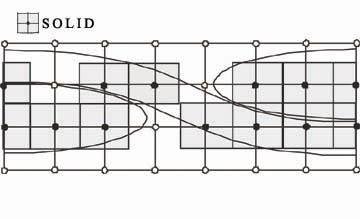
In both cases the permeability tensor

of the fabric is calculated via Darcy's law in
the composite unit cell
where

and

are the volume averaged fluid velocity and pressure.
Examples
Example 1: Permeable Square Array
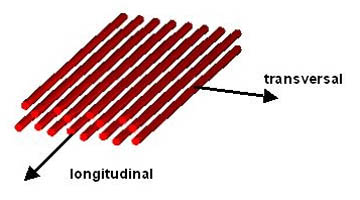
The above setup shows a parallel array of impermeable tows. And although this setup
is not close to actual textile reinforcements, theoretical predictions for
the permeability exist which make it an interesting test case. For this
porous structure we have validated the Navier-Stokes as well as the
Navier-Stokes-Brinkman model: The results of the permeability calculations
with Darcy's law coincide well with the theoretical ones. The pictures
below show the WiseTex Setup for the Permeable Square Array
and a slice through the resulting velocity field in flow direction
in a unit cell of the medium.
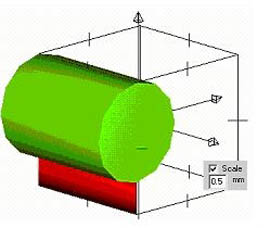
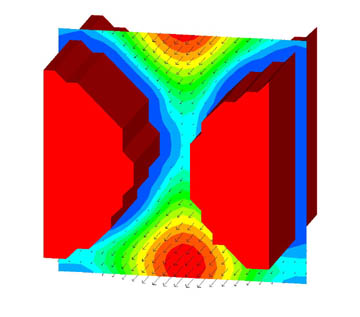
Example 2: Monofilament Fabric Natte 2115
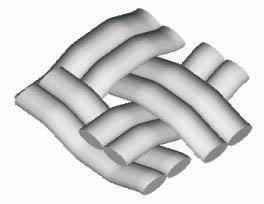
The Monofilament Fabric is a more realistic structure than the Permeable
Square Array. Here, it can be shown that the permeability
depends strongly on the nesting of the geometry: The calculated permeability
for a single layer of fabric will differ from the permeability of two layers
of fabric with various densities of nesting. Below, a maximum nested setup can
be seen opposed to a minimum nested setup, which has already been discretised
by NaSt3DGP.
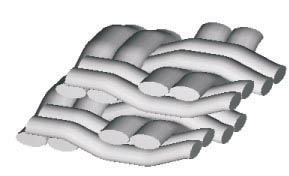
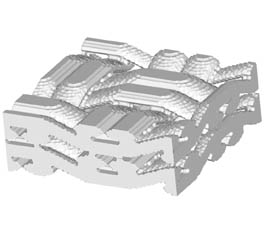
In the latter case, there are quite big gaps in the fabric where the fluid is only
slightly disturbed by the geometry and which then, of course, leads to an increase
in permeability as opposed to maximum nesting.
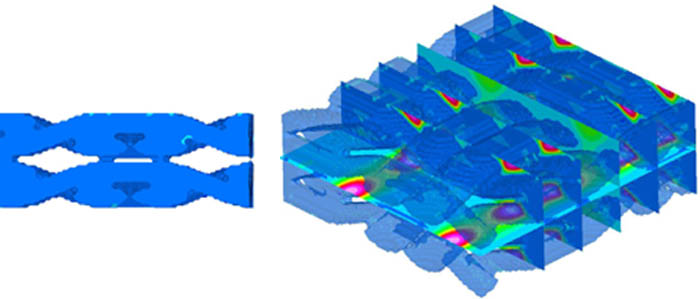
Cooperation
KU Leuven: Composite Materials group
KULeuven: Scientific Computing Research Group
References
| [1] |
Verleye B., Klitz M., Croce R., Roose D., Lomov S., Verpoest I., Computation of permeability of
textile reinforcements. 17th IMACS World Congress, 2005.
|
| [2] |
Belov E.B., Lomov S.V., Verpoest I., Peters T., Roose D., Parnas R.S., Hoes K., Sol H., Modelling of permeability
of textile reinforcements: lattice Boltzmann method. Composites
Science and Technology 2004; 64(7-8):1069-80.
|
| [3] |
Lomov S.V., Huysmans G., Luo Y., Parnas R.S., Prodromou A., Verpoest I., Phelan F.R., Textile composites: modelling
strategies. Composites Part A 2001: 32(10):1379-94.
|
| [4] |
Griebel M., Dornseifer T., Neunhoeffer T., Numerical Simulation in Fluid Dynamics, a Practical Introduction. SIAM, Philadelphia, 1998.
|
Related Projects


![]() denotes the permeability of the yarn,
denotes the permeability of the yarn, ![]() is the fluid viscosity and
is the fluid viscosity and ![]() the fluid density .
On the other hand, if intra-yarn porosity is neglected, yarns are merely treated as solid obstacles for the standard Navier-Stokes equations.
the fluid density .
On the other hand, if intra-yarn porosity is neglected, yarns are merely treated as solid obstacles for the standard Navier-Stokes equations.







